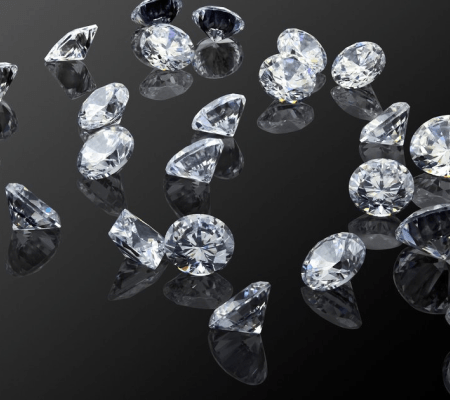
The round brilliant cut diamond is by far the most popular diamond cut. It is estimated that 50-75% of all diamonds sold are cut in this way. As its name implies, it is circular and displays an even, symmetrical brilliance. It is the most brilliant diamond cut, showing the sparkle and fire that diamonds are prized for.
The original round brilliant cut diamond was developed in 1919 by Marcel Tolkowsky. His thesis, Diamond Design, established the ideal proportions that a diamond should have to maximize its brilliance and dispersion of light. The modern round brilliant cut differs slightly from Tolkowsky’s in that it has a larger table, smaller culet, and longer and leaner facets overall. These changes help to reflect the light that enters the stone, back out into the eye of the beholder.
The round brilliant cut has 58 facets or 57 if there is no culet. The culet is a facet on the very bottom of the diamond that removes the sharpest point. Not all round brilliant cuts have this. The top part of the diamond is called the crown. It could be described as a window and frame to the diamond. The crown consists of one table facet, eight bezel facets, eight star facets, and sixteen upper girdle facets. The bottom part of the stone is called the pavilion. Its job is to redirect the light back out of the diamond. The pavilion consists of sixteen lower girdle facets, eight pavilion facets and one culet (if it has one). The girdle is the ring that goes around the widest diameter of the stone. It separates the crown from the pavilion. Most girdles also have small facets on them, but these are not counted in the total number. The facet count on the round brilliant cut is standardized, but the actual proportions are not universally agreed upon.
GIA Grading
The Gemmological Institute of America (GIA) spent 15 years studying how the light behaves in a round brilliant cut diamond. Their research used advanced computer modeling to analyze over 10k+ possible proportion combinations. They validated this research with the human eye, with over 70k+ observations on actual diamonds. GIA’s research resulted in the GIA cut grading system of a diamond, a 5-point scale from excellent to poor. Only round brilliant cuts have a GIA cut grade, as it conforms to a mathematical standard. The other diamond cuts, called fancy shapes, are more subjective and don’t have a one size fits all formula. The GIA studies how the diamond looks face-up as if it were set into an engagement ring. The proportions of the diamond are key, as the crown and pavilion angles and the relative measurements of the facets contribute to the sparkle of the stone. The highest classification for cut is triple excellent, meaning that the cut, polish and symmetry are all excellent.
Pricing
The round brilliant cut diamond is the most expensive cut by weight, in comparison to the fancy cuts. There are two different reasons for this. One is the law of supply and demand. As mentioned, the round brilliant cut is by far the most popular, and this high demand helps drive up the price. The second reason is because of how much of the rough diamond is lost during the cutting process. The natural diamond crystal is an octahedron shape, basically looking like two pyramids attached at the base. To manufacture a round brilliant cut, between 28-38% of the rough diamond is removed and wasted, raising the costs.
Despite the higher cost, the round brilliant cut remains at the height of its popularity due to its incomparable brilliance and fire. If you are in the market for a diamond and have trouble deciding which cut to get, you cannot go wrong with the round brilliant cut. It is a timeless classic that will never go out of style and is the diamond shape with the most sparkle!